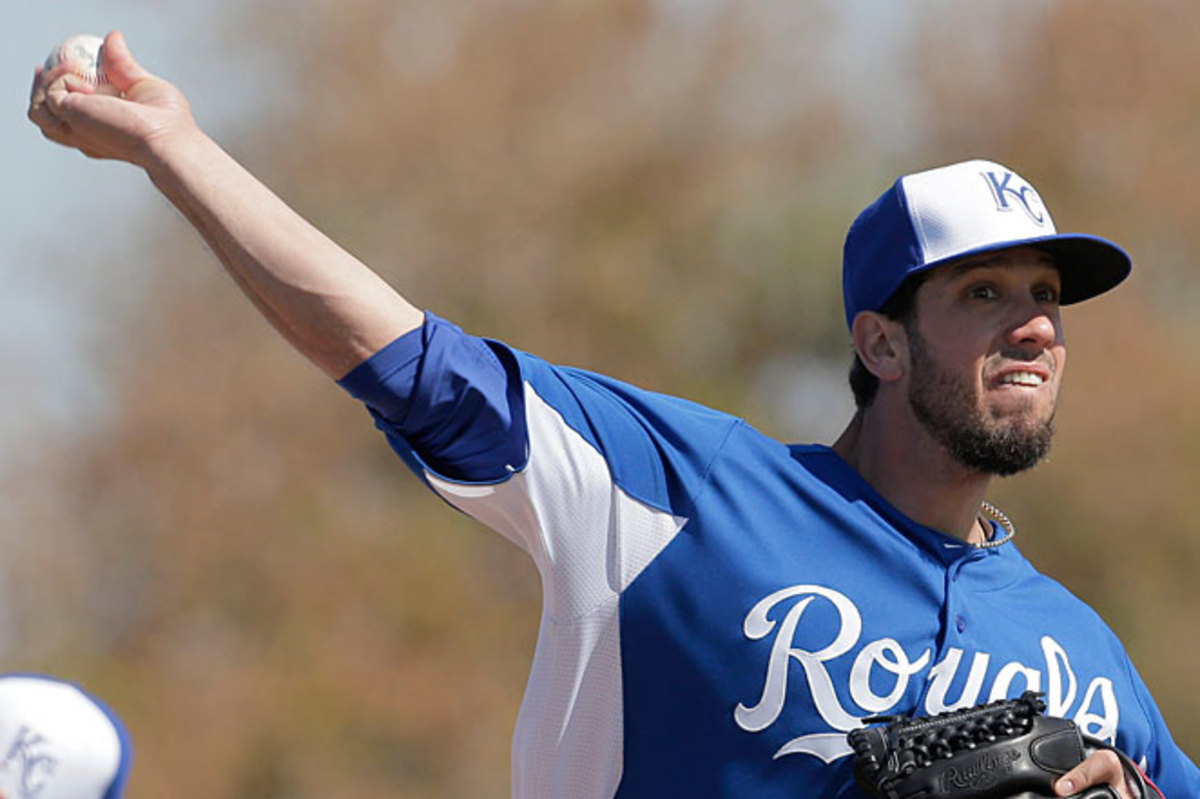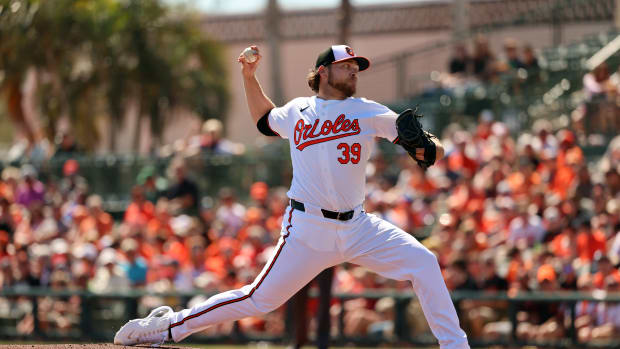
Royals need new arms to shoulder burden of moving into contention
SURPRISE, Ariz. -- The phrase "pitchers and catchers" is a baseball elixir, eliciting optimism where there has been none and hope where it had been dormant. The first workout of a new spring is a chance for teammates to reconvene, basking in the warmth of bright sunshine and brighter expectations.
On one side of the training complex in Surprise, however, it was more mixer than reunion, as Kansas City has added new four starting pitchers since last spring and three since the end of last season. After years of projections and prospects, the team and its fans are anxious to win now, seemingly making the Royals' reconstructed rotation a referendum on the direction of the franchise.
"It's a good thing that there is [an expectation]," new starter Wade Davis said. "You want to feel that, not necessarily pressure, but that energy that comes with that pressure, to really go out and set a tone."
The Royals acquired Davis and James Shields from the Rays for four prospects -- including consensus minor league player of the year Wil Myers and the club's top young pitcher, Jake Odorizzi -- in a bold move to further remake the pitching staff after trading for Ervin Santana from the Angels as well as re-signing Jeremy Guthrie, who first arrived in a trade last July.
Kansas City hopes those four men, who went through their first spring workout as Royals on Tuesday and who represent 80 percent of the team's projected starting rotation, are the influx of pitching talent needed to balance the high-ceiling consortium of homegrown position players.
"Our people have done a terrific job in scouting and player development, and now we felt like with this group of young players that we need to do everything we can to start winning now or you're not going to," Royals general manager Dayton Moore said. "If you wait two, three years and you're still trying to build and what have you, then I think your window closes rather quickly."
The Royals haven't had a playoff team since their 1985 World Series championship and have had just one winning season (2003) since 1994, but under Moore's watch, they built a historically great farm system. Leftfielder Alex Gordon and designated hitter Billy Butler were already in Double-A when Moore took over, but his staff assembled and developed a core of prospects and contributors that includes first baseman Eric Hosmer, third baseman Mike Moustakas, shortstop Alcides Escobar and catcher Salvador Perez, among many others, including Myers.
For a while the system's pitchers were on a similar track, before a few didn't develop as hoped -- such as Chris Dwyer and Mike Montgomery, who was also in the trade to Tampa Bay -- and others suffered a spate of injuries that included Tommy John operations for homegrown prospects Danny Duffy (who, coincidentally, threw off a mound on Tuesday for the first time since his surgery) and John Lamb, not to mention Felipe Paulino, who was acquired from Houston.
"To get talent, you've got to trade talent," Moore said. "We were able to keep the core group of our major league players together -- the homegrown players we've developed -- and use our farm system to acquire major league talent to blend in with this young group to hopefully put us in a position to win more games and hopefully set a different course for our organization."
Even though the Royals went outside their organization for pitching help, they were able to do so because of their homegrown resources in the farm system. In their market, outbidding other teams in free agency is rarely possible. Still, the trade of Myers incited considerable backlash, owing to the hype surrounding him and, as Kansas City Star columnist Sam Mellinger explained, Royals fans were trained to hate a trade in which they dealt away prospects after learning to buy into the hope of tomorrow.
The reality, however, is that the rotation needed help in a big way last year, and it got that help without trading a single player from the major league roster. And consider the scope of the reinvention necessary: the Royals ranked 26th in the majors in starters' ERA (5.01), 25th in strikeout-to-walk ratio (2.04) and 28th in innings (890). Almost every club's goal, which only a few achieve each year, is to reach 1,000 innings in a season; the Royals haven't gotten there since 1996.
"I understand the excitement of the fan base for the potential and I understand what Dayton and the coaching staff and the front office is trying to do -- they're trying to bring these two together, the future and the present," Guthrie said. "That's why you see the sacrifice of one of the top prospects in Wil Myers and the [minor league] pitcher of the year in Odorizzi for guys like Davis and Shields. They're trying to mesh these two eras together now, and I believe in it. I believe in what they're doing."
Shields is a proven workhorse, with six straight seasons of at least 200 innings -- a guy who "eats up innings with quality," said pitching coach Dave Eiland -- including 477 innings with a 3.15 ERA over the last two years. Davis pitched out of the bullpen for Tampa Bay in 2012, with a 2.43 ERA in 70 1/3 innings, appearing to reach his potential after two average seasons as a starter in 2010 and '11.
Santana, who for years had been a solid No. 3-caliber starter for the Angels, had a brutal first half of last season, with a 6.00 ERA through his first 19 starts but rallied with a 3.76 figure in his final 11 starts. "He had a big hole to dig himself out of," Eiland said, "so the overall numbers weren't real Ervin Santana-like, but the way he pitched the second half was."
Guthrie had a similar second-half rebound. He started the year with the Rockies, where he struggled badly at home (9.50 ERA) but pitched well on the road (3.67 ERA) before being traded to the Royals, where he was good no matter where he pitched with a 3.16 ERA in 14 starts. He noted making a few minor adjustments after landing in Kansas City, and he also stressed that the Royals' defense was underrated and probably the best he had ever pitched in front of.
The best-case scenario is that the Royals follow the lead of their major trading partner, the Rays, who steadily built a farm system before exploding into the playoffs with a 31-win improvement five years ago. Kansas City doesn't need quite that many -- it won 72 a year ago -- but it will need at least half that many more to sniff the postseason.
"I see a lot of similarities," Shields said, "especially early in that transition from 2007 to 2008 when the Rays had a lot of talent but had never really put it all together, and I think this team is definitely capable of winning and winning a lot of ballgames."
The Tigers are formidable but they claimed the AL Central with just 88 wins last year, six fewer than any other division winner. The Indians are greatly improved after a busy offseason, and the White Sox return almost everyone from an 85-game winner. But it's still easy to dream -- and not just on the first day of pitchers and catchers workouts -- on the Royals' chances of at least hanging around long enough to play meaningful games in September.



































